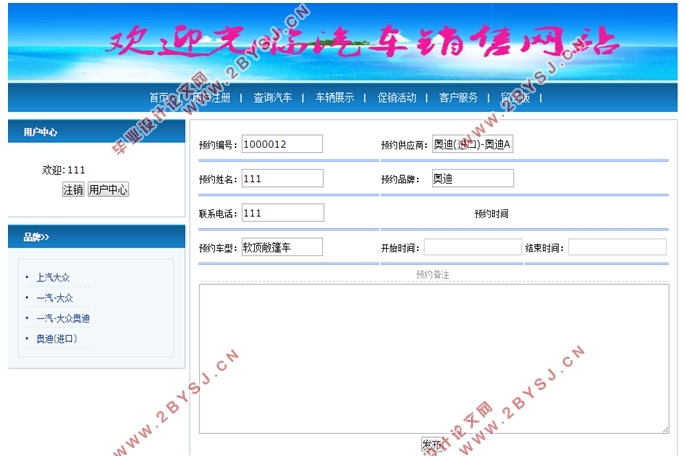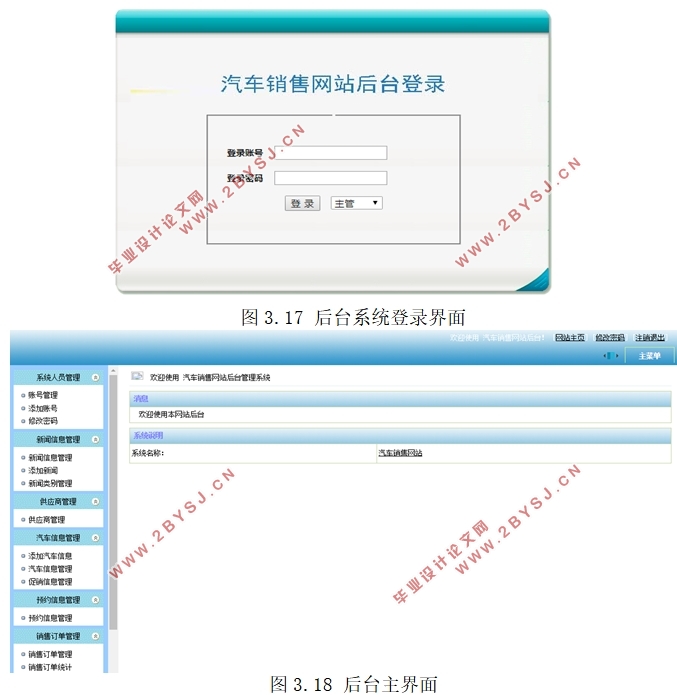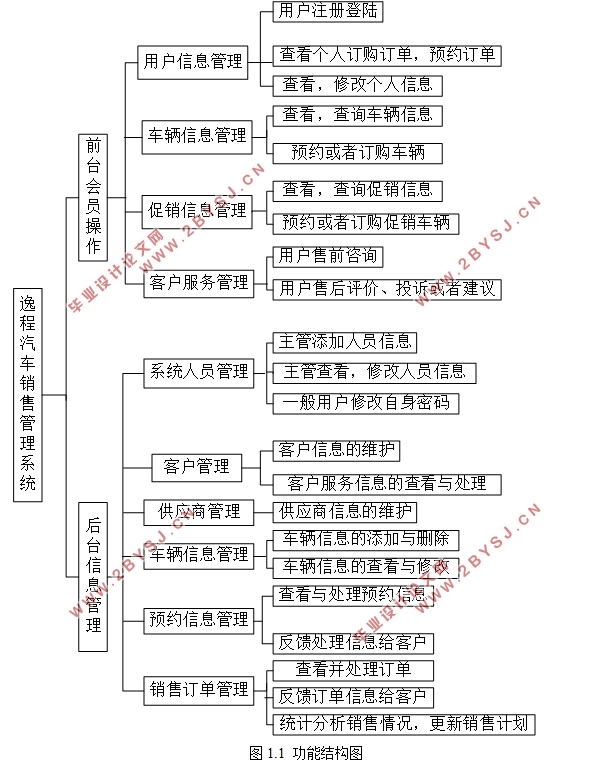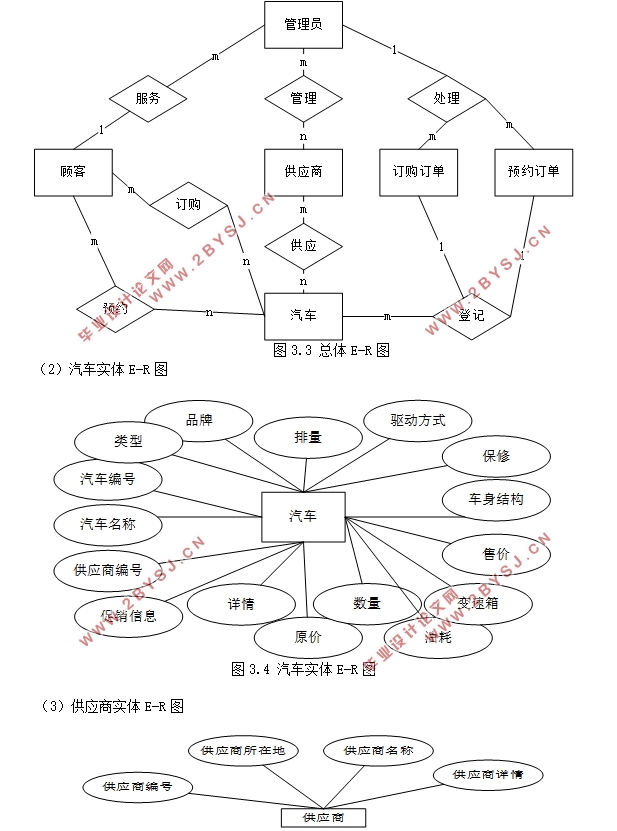汽车销售网站管理系统的设计(ASP.NET,SQL)
无需注册登录,支付后按照提示操作即可获取该资料.
汽车销售网站管理系统的设计(asp.NET,SQL)(任务书,开题报告,论文说明书13000字,程序代码,SQLserver数据库)
摘 要
随着互联网技术的快速发展,电商网络已经覆盖全球,人们从最初的在网上浏览网页导现在的淘宝购物,在网上购买各种各样的商品,“互联网”这个名词的含义发生了巨大的变化。现在电商主要集中在服饰、家电、食品等价值不高,便于运输的商品范围,而向汽车这种大型商品,售卖的网站比较少,国内也大多数是作为供应商与顾客之间的一个中介平台,并没有真正的售卖汽车。从顾客方面来说,有一些方面的担心,如质量风险等,在网站浏览信息远不如亲身实际体验比较全面和直观。
但我相信,未来,随着汽车销售网站的不断完善,尤其是服务方式、配送方式等,尤其是快节奏的生活,使得越来越多的网民将会被汽车销售网站所吸引,网民对汽车销售网站也将必定会从最开始的拒绝、难以新人到最后的欣然接受,甚至是依赖。
在互联网上通过它,用户可以突破时空限制,实现网上购买汽车,为消费者带来了很大的方便;方便管理员的管理与维护是它的最大的一个优点,节省时间和精力。它还具有运行成本低,库存虚拟,用户搜索方便,地理限制少等特点
本论文主要分为4个部分,第一部分为绪论,主要是汽车销售网站的国内外研究现状和选题的目的和意义;第二部分是逸程汽车销售网站的需求分析、可行性分析、业务流程以及数据流程等的分析;第三部分是逸程汽车销售网站的设计部分,主要是数据库设计和功能设计;第四部分主要是系统调试方案的制定与执行情况;最后是结束语
关键词:B/S结构;C#汽车销售;数据库;asp.net
Abstract
With the rapid development of Internet technology, electricity network has been covering the world, people from the initial online browsing online guide Taobao shopping, online to buy a variety of goods, "Internet" the meaning of the term has occurred a huge Variety. Now the electricity business mainly concentrated in the clothing, home appliances, food and other value is not high, easy to transport the scope of goods, and to the car this large commodity, the sale of the site is relatively small, most of the domestic as a supplier and the customer Intermediary platform, and no real sale of cars. From the customer side, there are some aspects of worry, such as quality risk, etc., in the website browsing information is far better than the actual experience is more comprehensive and intuitive.
But I believe that the future, with the car sales site constantly improve, especially the service, distribution, etc., especially fast-paced life, making more and more Internet users will be attracted by the car sales site, Sales site will also be from the beginning of the refusal, it is difficult to newcomers to the last pleased to accept, or even rely on.
Through the Internet through it, users can break through time and space constraints, to achieve online purchase of cars, for consumers to bring a lot of convenience; to facilitate the management and maintenance of the administrator is its biggest advantage, save time and effort. It also has a low operating costs, inventory virtual, user search convenience, less geographical features
This paper is divided into four parts, the first part is the introduction, mainly the domestic and international research status and the purpose and significance of the automobile sales website; the second part is the demand analysis, feasibility analysis and business of the yacht car sales website Process and data flow analysis; the third part is the design part of the yacht car sales website, mainly the database design and functional design; the fourth part is the system debugging program development and implementation; Finally, concluding remarks
Key words: B / S structure;C # car sales;database;asp.net
功能模块结构设计
该系统的功能结构如图所示:系统后台根据不同的人员使用不同的模块。主管可以使用所有模块;营销人员可以修改自身密码,供应商以及汽车信息管理,促销活动管理,销售订单的管理与统计分析;客服人员可以修改自身密码,进行预约订单以及销售订购订单的处理,客户信息的管理以及客户服务
系统的详细功能介绍:
1、前台:
(1)用户管理:用户注册,登录,个人信息维护,购车订单以及预约订单的详细信息的查看,如订单的状态,确认收货等
(2)车辆展示:根据展示的汽车图片和关键信息,选择感兴趣的车辆进行详情查看,之后进行车辆的订购或者预约
(3)促销活动:选择感兴趣的车辆进行促销信息以及车辆信息的查看,之后进行车辆的预约或者订购
(4)订购车辆:选择心仪的车辆后,订购车辆,选择服务方式以及支付方式,确认订单信息并完成订购,确认订单后,如果车辆未发货,可以申请取消订单或者退款。如车辆已经发货,则可以选择确认收货或者申请退款,之后等待客服确认并反馈信息。
(5)预约试驾:客户选择车辆后,进入预约界面,填写相关的预约信息,如预约日期,联系方式,备注等,确认预约订单
(6)查询汽车:通过关键词的输入,查询特定品牌,供应商,类型的汽车,进行快捷选购
(7)客户服务:进行汽车相关信息的售前咨询,购买车辆或预约看车后对汽车或者客服人员进行相应的投诉、建议、评价等信息反馈
2、后台:
(1)系统人员管理:主管可以查看及修改所有人员信息,其他人员进行自身密码的修改
(2)供应商管理:营销人员对供应商信息进行添加、删除和修改
(3)汽车信息管理:营销人员对供应商信息进行添加、删除和修改并根据销售状况制定促销活动
(4)预约信息管理:主管将预约订单按供应商分配给客服代表后,客服代表对用户下达的预约订单进行处理,并反馈信息给客户
(5)销售订单管理:主管将销售订单按供应商分配给客服代表后,客服代表对订单进行处理,有三种处理情况,一个是正常确认发货,汽车数量相应减少;另一个是客户未发货状态申请取消订单或者退款,客服视情况进行处理或者和客户交流;最后是已经发货,那么客户只能选择收货或者申请退款,客户灵活处理。
(6)销售订单统计:营销人员根据需求对销售订单进行统计分析,根据销售情况,调整供应商信息,汽车信息以及促销活动信息
(7)客户服务管理:客服对售前咨询,售后评价、投诉或者建议进行处理,并反馈信息给客户
开发环境:Microsoft visual studio
数据库工具:SQL Server





目 录
摘 要 I
Abstract II
第1章 绪论 1
1.1设计的目的及意义 1
1.2国内外研究现状 1
1.2.1国内现状 1
1.2.2国外现状 2
1.3设计内容与设计方法 2
1.3.1系统目标及基本内容 2
1.3.2技术方案和措施 4
第2章 系统分析 6
2.1 需求分析 6
2.2 可行性分析 6
2.3 业务流程分析 7
2.4 数据流程分析 9
2.5 数据字典 12
2.6.1 数据元素 12
2.6.2 数据流 14
2.6.3 数据存储 15
2.6.4处理过程 16
2.6.5外部实体 19
第3章 系统设计 20
3.1 系统总体设计 20
3.1.1 功能模块结构设计 20
3.1.2 物理配置方案设计 21
3.2 系统详细设计 23
3.2.1编码设计 23
3.2.2数据库设计 23
3.2.3 输入输出及界面设计 32
第4章 系统实施 36
4.1 系统调试 36
4.2 系统测试 36
4.1.2 系统测试计划的制定 36
4.1.3 系统测试用例的设计 36
4.3.3 系统测试计划的执行 37
4.3.4 缺陷管理与改错 37
第5章 结束语 38
参考文献 39
致 谢 41
